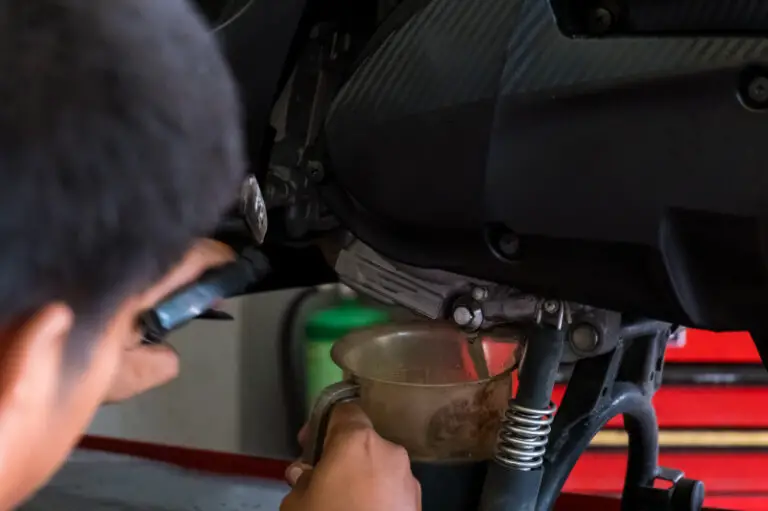How to Test a Motorcycle Rectifier (8 Steps)
Disclosure: We may get commissions for purchases made through links in this post.
A functioning motorcycle rectifier regulator is key to a bulletproof and reliable two-wheeler. Its condition impacts not only a motorcycle’s on-road performance but also its market value.
With this in mind, manufacturers have designed rectifiers to last a lifetime. But with variables such as temperature and riding behaviors (among others), this component can become flawed and may call for testing.
Testing a motorcycle rectifier involves the following processes — checking for voltage and resistance, bypassing the voltage regulator, conducting a diode test, and examining the bike for a possible diode leak. Most of these tests require a multimeter, although a voltmeter would also suffice.
For a more detailed breakdown, here are the eight steps on how to test a motorcycle rectifier:
- Fully charge your battery.
- Check for open-circuit voltage.
- Rev the motor.
- Do a DC voltage regulator test.
- Perform a voltage drop test.
- Bypass the regulator.
- Check for a possible diode leak.
- Conduct a motorcycle rectifier test.
Electrical gremlins like motorcycle rectifiers often scare people off — but they should not. I would not say that testing a motorcycle rectifier is a piece of cake. But with the right tools and a solid working knowledge of your two-wheeler’s circuitry (with which I will help you in this guide), successfully testing and diagnosing this component is not something you cannot handle.

How to Test a Rectifier on a Motorcycle
A dysfunctional motorcycle rectifier regulator usually results in a weak, dead, or overcharged battery (view on Amazon) — definitely not something you would want to happen. So if you notice your headlights burning out quickly or flickering at higher RPMs, rule out your speculations by performing a motorcycle rectifier test (among other procedures), as detailed in this section.
Key Pointers:
- Set the multimeter to read DC voltage — select 20 volts in the scale.
- The typical range is between 12.5 volts DC and 12.9 volts DC for open-circuit voltage or between 13.2 volts DC and 14.8 volts CD after starting the engine (best to refer to the owner’s manual or battery specifications for this information).
- If the readings stay within the 12.5 volts DC to 12.9 volts DC range after revving the motor, you may have a bad alternator.
- If the readings fluctuate during the procedure, test for a possible diode leak with the AC voltage scale selected (and while the engine is still running).
- Testing procedures are contingent on the type of motorcycle rectifier regulator (ex. 3-pin, 4-pin, 5-pin or prong, single-phase, two-phase, three-phase, or universal 12V). That said, always revert to your owner’s manual for specifics, and do not attempt to perform any troubleshooting steps in this guide if you are not handy.
1. Fully Charge Your Battery.
Ascertain your battery is fully charged before performing this test. Also, your bike should be idling.
2. Check for Open-Circuit Voltage.
Before connecting the positive and negative leads to their respective battery terminals, set your multimeter to read volts DC, then check the battery’s open-circuit voltage. The battery should give you a reading of approximately 12.5 volts DC to 12.9 volts DC.
3. Rev the Motor.
Rev to 5,000 RPM. Some OEMs require only 1,500 RPM, so check your owner’s manual for guidance.
4. Do a DC Voltage Regulator Test.
Test the battery terminals mirroring step #2. If your motorcycle rectifier regulator is functioning correctly, the voltmeter/multimeter should throw a reading between 13.2 volts DC to 14.8 volts DC.
Key Pointers:
- Readings lower than this range or OEM-specified values imply a failure in the bike’s charging system and the rectifier regulator as the potential culprit.
- Readings higher than this range or OEM-specified values may mean that the operation of your motorcycle is well beyond its tolerance band and is pushing the battery and charging system into saturation. When this happens, the battery and any voltage-sensitive electronics on the bike are bound to get damaged.
5. Perform a Voltage Drop Test.
Consider testing charging system components should voltage readings fall outside the 13.2 volts DC to 14.8 volts DC range.
For readings of 16 volts DC or higher, prepare for possible replacement of your voltage regulator.
For readings below lower-limit values, conduct a voltage drop test. The steps below by Axle Addict apply to automobiles but also give a clear picture of how to go about the process on two-wheelers:
- Step #1: Set 2 volts on the voltmeter.
- Step #2: Let the engine idle.
- Step #3: Measure for voltage across the charging system’s connections and individual wires.
- Step #4: If there are over 0.2 volts in any connection or wire, look for damaged, corroded, or loose wires.
- Step #5: When fixing connections, check for a voltage drop of less than 0.1 volts or 0.
It is crucial that the above voltage drop parameters are met, as excessive resistance in your motorcycle’s charging system circuit dramatically reduces current flow.
Additionally, it keeps adequate amounts of current from reaching different charging system components, adversely affecting the motorcycle’s operation.
6. Bypass the Regulator.
A regulator bypass test is another way to determine if the regulator part of your motorcycle rectifier or another charging system component is at fault. It is not a cookie-cutter procedure, though, as the charging system configuration varies per motorcycle type.
Additionally, the voltage regulator may connect to either the circuit’s power (type B) or ground (type A) side. For specifics on how to go about bypassing your voltage regulator, consult your owner’s manual.
Key Pointers:
- Before starting, ensure all electrical accessories are off.
- Disconnect your jumper wires the moment the multimeter reads the charging voltage.
- Remember to turn off the engine.
Keep an eye out for the voltage output. If it is at the maximum level, it means your regulator is bypassed and not the culprit. If normal, your regulator may be defective.
But the alternator is likely to blame if the output level is low. It is also possible that the contact points (and not the voltage regulator) are faulty, so check on them.
7. Check for a Possible Diode Leak.
Testing for this type of leak entails switching your voltmeter/multimeter to the AC voltage scale and pulling voltage readings while the motor is still running. But unlike the preceding steps, connect the positive (red) lead to the B+ terminal on the rear of the alternator and the negative (black) lead to the battery’s negative terminal.
At this point, you are basically doing a diode test — meaning you are testing each diode’s forward and reverse bias to see if they are permitting or stopping the flow of electricity accordingly.
Getting 0.25 volts AC on the meter warrants replacing the alternator — although some OEMs set the threshold to 0.50 volts AC before doing so. According to forums and other online resources, the latter seems to be the threshold most people follow. But consult your owner’s manual for acceptable diode leak rates to be sure.
Be wary of MOSFET rectifier circuits, too, as they operate differently from standard circuitry and may not conform to the usual thresholds.
If the initial output voltage is within spec, increase the engine speed to 2,000 RPM and turn on high-current accessories before taking another voltmeter reading. This time, the voltage output should be approximately 0.5 volts higher than your battery’s open-circuit voltage (given normal temperature, a fully charged battery, and no accessories or lights on).
This voltage ceiling will vary depending on application, although most rectifier regulators are calibrated between 13.5 and 15.5 of output voltage.
8. Conduct a Motorcycle Rectifier Test.
Doing the DC voltage test essentially tests how well your battery is being charged and only generally confirms that something is wrong with your motorcycle rectifier regulator.
But since the latter is bi-functional, readings from the voltage test alone would not suffice. Hence, you will need to test its two functions separately, which means testing the motorcycle rectifier block on its own.
Key Pointers:
Finding the rectifier portion of your rectifier regulator should be fairly easy with the guidance of a diagram or YouTube tutorial. But if you find ourself having difficulty as early as this step, it is a sign you should outsource this task to someone more mechanically inclined.
- Remove the rectifier block from the motorcycle rectifier regulator. Refer to your owner’s manual for its location.
- Set your multimeter to the diode testing function.
- Identify the positive and negative leads (terminals) on the battery side.
- Connect the negative lead to the bike’s stator coils or inputs and the positive lead to the positive diode. The multimeter should not give you any readings. Otherwise, it means you have a bad rectifier.
- Repeat step #3 but connect the negative lead to the positive diode and then the positive lead to the stator coils or inputs (connect the prongs one at a time). Again, the multimeter should not display any readings. Getting readings doing this specific step implies charging problems caused by a bad rectifier.
- Disconnect all leads. Connect the positive lead to the negative lead on the battery side. Conversely, connect the multimeter’s negative lead to each of the three terminals found on the alternator side of the rectifier (again, do this one at a time). If the rectifier works properly, each prong should register a reading between 0.4 and 0.52 volts.
Tools for Testing:
- Diagnostic scan tool (optional)
- Voltmeter (for testing overcharge)
- Multimeter like Fluke 107 AC/DC Current Handheld Digital Multimeter (view on Amazon) and measurement probes (for diode/DC voltage testing)
- Ohm meter
- Battery charger or maintainer
Symptoms of a Bad Motorcycle Rectifier

Illuminated Check Engine or Battery Light
Not all two-wheelers have this warning light. But if they do, it will surely be set off if the rectifier regulator is not working properly. An activated CEL or battery light is not exclusive to a motorcycle rec-reg and can be prompted by several other issues. Therefore, thorough testing and diagnosis are necessary when narrowing down its problem source.
Using a high-spec scanner like the 2022 Elite Version LAUNCH X431 Diagun V Bi-Directional Scan Tool (view on Amazon) is optional and would only apply if the diagnostic port of your motorcycle is a CAN BUS or is OBD2-compliant.
Electronics and Lighting Going Haywire
When lights appear brighter, and electronics start having output spikes, your battery may not be getting enough charge. Either that or the condition of your motorcycle rectifier regulator may be too far gone. But in truth, these two are still considered by many motorheads as not that severe.
Worst-case scenarios linked to high voltage output usually translate to a non-working digital display and your lighting assembly dying — both of which could put you at risk if they happen while you are on the road.
Faulty Instrument Cluster
Apart from having erratic behaviors, a compromised motorcycle rectifier regulator can render your instrument cluster useless. This observation is especially true for modern types that are not only voltage-sensitive but also designed to work on DC power exclusively.
When the rectifier portion of the component goes bad, AC power makes its way to the instrument cluster — causing the latter to become defective or, worse, inoperable in the long run.
Overheating
One tell-tale sign of a motorcycle rectifier gone awry is overheating. And I do not just mean the engine, as overheating can also be experienced in other areas of a motorcycle.
Several factors can lead to this symptom surfacing. One of the most common causes is a battery with bad groundings or connections, which messes with the current flow and overheats the rectifier-regulator.
A faulty alternator likewise leads to overvoltage. Another likely culprit is the placement of your rectifier regulator.
If the rectifier is too near the radiator, the latter’s heat can be too much to handle. Eventually, this results in parts surrounding the rectifier feeling unusually hot to the touch.
Intermittent Starting
Starting issues (including cold starts) are not among the first indicators of a bad rectifier regulator. It is actually the result of not tending to a faulty rec-reg for far too long or your battery receiving unclean energy.
A motorcycle rectifier regulator gone bad depletes the battery of its charge gradually. And unfortunately, there is no specific timeframe for this happening. You would not even be aware of its effect until you start experiencing starting issues alongside other accompanying symptoms.
Occasional Power Dips
A bad rectifier regulator may cause voltage-fed components like the fuel pump, injectors, and ignition system (among others) to malfunction. This list is non-exhaustive, as many other motorcycle components require a minimum amount of voltage to work.
You may experience rough idling, occasional sputtering, or a lack of acceleration when you ride. Never regard these symptoms lightly, as they suggest that the power regulation in your motorcycle is not happening correctly.
Corrosion on Battery Terminals
Rust formation on the terminals may be more associated with a battery leak, but they also signify a rectifier regulator failure (among other things). Adherence to scheduled maintenance and regular battery inspection would typically reveal this symptom.
Fluctuating Voltage
Although not as apparent as other symptoms, it is a sure-fire indicator of a bad motorcycle rectifier regulator. The regulator portion of your rec-reg component is responsible for maintaining DC voltage at a steady level.
Barring complications, you should expect stable up-to-spec readings if your regulator is fine. Conversely, a burnt-out shunt regulator will give you fluctuating voltage readings in your multimeter.
Run-Down Battery
A dead battery is arguably the most obvious sign of a compromised motorcycle rectifier regulator.
The rectifier portion of this component converts AC power from the alternator into DC voltage. Meanwhile, the regulator keeps the current flow of the converted electricity smooth and steady for your battery and other electronics to utilize.
When the rectifier regulator is flawed, the battery will naturally not get sufficient charge and start depleting its own output voltage. And when this occurs repeatedly, the battery’s state will end up beyond revival.
Note, however, that the motorcycle rectifier regulator is not the only one to blame for this outcome. Premature aging of a battery can also be attributed to other factors like engine vibration, exposure to heat, fast charging, and lack of maintenance. That said, look into other potential causes as well.
How Much Is a Motorcycle Rectifier Repair Worth?
The answer is $0 — because you cannot repair a faulty motorcycle rectifier regulator. If found defective, the component actually needs to be replaced immediately.
A brand-new rectifier regulator will cost anywhere from $150 to $380 (parts and labor included). However, this price is subject to increase depending on the bike’s make and model, whether or not an OEM replacement is purchased.
Another variable to this price is complications caused by the bad rectifier, such as burnt wires and electrical damage. To avoid hefty labor rates, I strongly suggest replacing your motorcycle rectifier regulator if you are approaching 100,000 miles or so on your motorcycle.
Can a Motorcycle Run Without a Rectifier?

Provided its battery is in good shape and fully charged, nothing can stop a two-wheeler from running, even without a rectifier. But as soon as there is drain on the battery, running a motorcycle without a rectifier would be counter-intuitive.
Batteries and other electronics feed off DC voltage. Without a motorcycle rectifier, there is nothing to convert the AC power from the bike’s charging system or alternator into the DC format the battery needs.
Conclusion – How to Test a Motorcycle Rectifier
To recap, here are the steps on how to test a motorcycle rectifier:
- Fully charge your battery.
- Check for open-circuit voltage.
- Rev the motor.
- Do a DC voltage regulator test.
- Perform a voltage drop test.
- Bypass the regulator.
- Check for a possible diode leak.
- Conduct a motorcycle rectifier test.
There’s no universal way on how to test a motorcycle rectifier, as there are way too many types of circuitry and variables in play. The best thing to do is to prevent having to test the component in the first place.
You can do this by refraining from abusing your motorcycle, keeping your battery and cabling up to snuff, and regularly inspecting your electricals and charging system.
Still, it would help to be familiar with the different testing procedures involved, especially if you suspect issues with your motorcycle rectifier regulator. And if you’re dealing with a bad motorcycle rec-reg, I hope this article helps you with the task.







